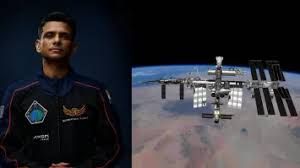Shubhanshu Shukla on ISS mission: Top 10 facts about International Space Station

In a landmark moment for India, Group Captain Shubhanshu Shukla is set to become the first Indian astronaut to visit the International Space Station (ISS). His upcoming mission aboard Axiom Space’s Ax-4 is not only a personal milestone but also a major leap for India’s aspirations in human space exploration. As anticipation grows around his mission, here’s a look at 10 fascinating facts about the ISS, the orbital laboratory where Shukla will carry out critical scientific research.
1. ISS Orbits Earth 16 Times a Day
The ISS isn’t stationary—it zips around our planet at 28,000 kilometers per hour. That means it completes one full orbit every 90 minutes, offering astronauts 16 sunrises and sunsets each day. This rapid orbit allows them to see the Earth from different perspectives in just a single day.
2. It’s As Big As a Football Field
When people imagine a “space station,” they often picture something small and cramped. However, the ISS is huge—about 357 feet long, which is roughly the size of a football field. Its interior living space is more than 388 cubic meters, giving astronauts room to work, sleep, and even exercise.
3. A Truly International Collaboration
The ISS is a global achievement, jointly developed and operated by five space agencies: NASA (USA), Roscosmos (Russia), JAXA (Japan), ESA (Europe), and CSA (Canada). Over 15 countries have contributed to its construction, making it a symbol of international cooperation in space science.
4. Over Two Decades of Human Presence
The ISS has been continuously inhabited since November 2000. That’s over 24 years of non-stop human presence in low Earth orbit. Hundreds of astronauts, cosmonauts, and space tourists have called it home, contributing to thousands of scientific studies that benefit life on Earth.
5. A Floating Laboratory
With over 3,000 scientific experiments conducted so far, the ISS is a hub for research in fields like biology, physics, medicine, and material science. Shubhanshu Shukla’s mission will add to this legacy, with planned experiments focusing on microgravity’s effect on human cells and materials, feeding into India’s future missions such as Gaganyaan and Chandrayaan.
6. Water from Sweat and Urine? Yes!
Water is a precious resource in space. That’s why the ISS recycles nearly 90% of its water, including moisture from the air, sweat, and even urine. Thanks to the Water Recovery System, astronauts can stay hydrated without constantly needing fresh water supplies from Earth.
7. Workouts Are Mandatory
Microgravity can wreak havoc on the human body, leading to muscle atrophy and bone loss. To stay healthy, astronauts exercise for nearly two hours every day using treadmills, cycling machines, and resistance equipment. These workouts help maintain bone density and cardiovascular fitness.
8. Robotic Arms & Spacewalks
Astronauts on the ISS often perform spacewalks—officially called EVAs (extravehicular activities)—to repair and upgrade the station. Over 230 spacewalks have taken place so far. Robots like Canadarm2, a 17-meter-long robotic arm, assist in these complex operations, moving modules and cargo around the station.
9. Power from the Sun
The ISS is powered entirely by solar energy. It has eight massive solar arrays that generate between 75 to 90 kilowatts of electricity—enough to power more than 50 homes on Earth. These panels rotate to follow the sun, maximizing energy efficiency.
10. Retirement Plan in Place
Despite its remarkable achievements, the ISS is nearing the end of its operational life. Current plans suggest it will be decommissioned by 2030. It will be safely guided back to Earth, with leftover debris expected to land in a remote part of the Pacific Ocean called Point Nemo—often referred to as the space cemetery.
🇮🇳 Shubhanshu Shukla: India’s Astronaut of the Future
Born into a family with a deep commitment to public service, Group Captain Shubhanshu Shukla is a decorated Indian Air Force pilot and test pilot. His selection for the Axiom-4 mission marks a watershed moment in India’s space history. Though this mission is coordinated by a private US company (Axiom Space) in partnership with NASA, it is expected to pave the way for India’s own human spaceflight efforts.
During his 14-day stay aboard the ISS, Shukla will conduct scientific experiments, interact with international crewmates, and represent the growing capabilities of ISRO and India’s space program. The mission, originally scheduled for June 2025, was recently delayed due to additional safety inspections, with a new date expected soon.
✨ Why This Mission Matters for India
- Builds technical and scientific capacity for India’s future space missions.
- Opens doors for commercial space partnerships and international collaboration.
- Inspires a new generation of scientists, engineers, and space enthusiasts across the country.
- Helps ISRO gather vital microgravity data for the upcoming Gaganyaan mission.
Conclusion
The International Space Station is more than just a structure floating above Earth—it’s a symbol of human unity, scientific progress, and daring exploration. With Shubhanshu Shukla’s participation, India takes a bold step into this elite club of nations sending astronauts to space. As we wait for the updated launch date, one thing is clear: the story of India in space is just getting started—and it’s reaching new heights.






